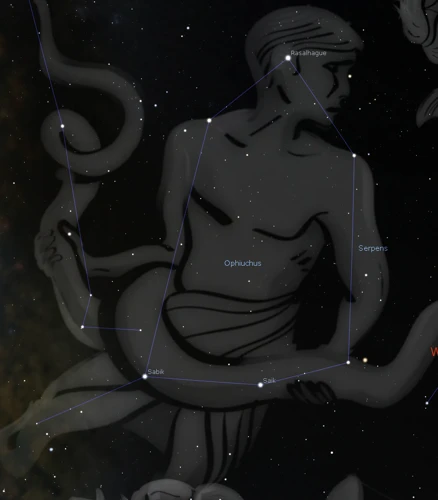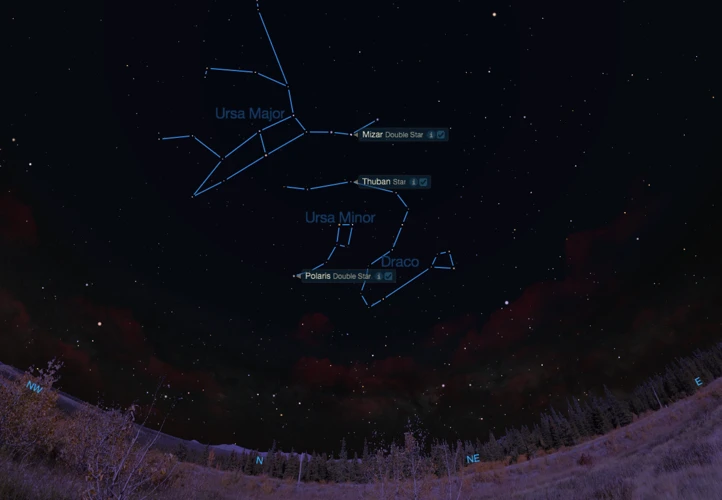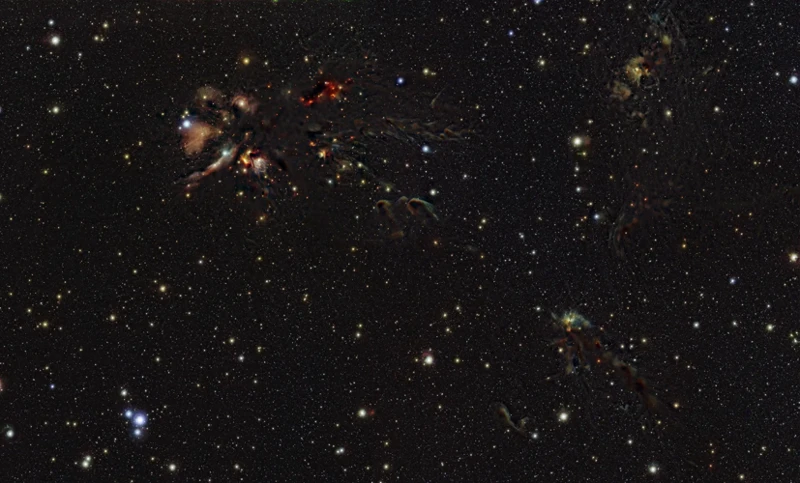In the vast expanse of the night sky, where stars twinkle and galaxies swirl, lies a queen who has captivated the imaginations of humans for centuries – Cassiopeia. This constellation has a rich mythological background, shrouded in tales of vanity, sacrifice, and eternal punishment. From Greek mythology to Arabian and Chinese folklore, Cassiopeia’s story has permeated various cultures throughout history. The influence of Cassiopeia can be observed not only in ancient mythology but also in art, literature, and even scientific discoveries. Join us on a celestial journey as we delve into the captivating mythology, cultural significance, and stellar features of Cassiopeia, and uncover the enduring legacy of this celestial queen.
Contents
- The Origins of Cassiopeia
- Cassiopeia’s Mythological Story
- Cassiopeia in Different Cultures
- Constellation Observation and Stellar Features
- The Legacy of Cassiopeia
- Conclusion
-
Frequently Asked Questions
- Who was Cassiopeia in Greek mythology?
- What was Cassiopeia’s punishment?
- What is the story of Cassiopeia’s sacrifice?
- How does Cassiopeia influence astrology?
- What is the significance of Cassiopeia in Arabian mythology?
- How is Cassiopeia depicted in Chinese mythology?
- Has Cassiopeia influenced art and literature?
- What scientific discoveries are associated with Cassiopeia?
- What is the cultural significance of Cassiopeia?
- Where can I learn more about the role of constellations in astrology?
- References
-
Frequently Asked Questions
- 1. Is Cassiopeia a real queen or just a mythological character?
- 2. How did Cassiopeia end up as a constellation in the night sky?
- 3. What is the significance of Cassiopeia in different cultures?
- 4. What is the story behind Cassiopeia’s boastful nature?
- 5. What was the defiant sacrifice made by Cassiopeia?
- 6. How did Cassiopeia receive heavenly punishment?
- 7. What role does Cassiopeia play in Arabian mythology?
- 8. How does Chinese mythology interpret the story of Cassiopeia?
- 9. How does Cassiopeia influence astrology?
- 10. What are the main features of the Cassiopeia constellation?
- References
- Read More
The Origins of Cassiopeia

The origins of Cassiopeia, the majestic queen in the stars, can be traced back to Greek mythology and its rich tapestry of celestial tales. According to Greek lore, Cassiopeia was a beautiful but boastful queen, known for her unparalleled vanity. Legend has it that she claimed to be more beautiful than the sea nymphs, the Nereids, which enraged the sea god Poseidon. As a result of her hubris, Cassiopeia and her family faced a series of trials and tribulations, including a defiant sacrifice and a heavenly punishment. Interestingly, Cassiopeia also holds significance in Arabian and Chinese mythologies, where her story takes on different nuances. Join us as we unravel the captivating mythology surrounding Cassiopeia and explore her influence on various cultures and even astrology.
The Greek Mythology
In Greek mythology, the story of Cassiopeia begins with the boastful queen herself. Cassiopeia was renowned for her exceptional beauty and took great pride in it. She even went as far as comparing herself to the sea nymphs, the Nereids, and claiming that she was more beautiful than them. This arrogant declaration angered Poseidon, the mighty god of the sea. Offended by Cassiopeia’s audacity, he decided to punish her and her entire kingdom. As a consequence, Poseidon sent a devastating sea monster named Cetus to wreak havoc on the coasts of Cassiopeia’s land. To seek redemption and appease the gods, Cassiopeia and her husband, King Cepheus, consulted an oracle who advised them to sacrifice their daughter, Andromeda, to the monster. This sacrificial act was meant to atone for Cassiopeia’s pride and save their kingdom from destruction. However, the heroic demigod Perseus intervened, saving Andromeda from her fate by slaying the fearsome Cetus. The Greek mythology surrounding Cassiopeia is filled with themes of punishment, redemption, and the consequences of arrogance. Her story serves as a cautionary tale of the dangers of hubris and the importance of humility in the face of divine powers.
Cultural Significance
Cassiopeia’s cultural significance extends far beyond the realm of Greek mythology. Throughout history, she has been revered and interpreted in various ways by different cultures around the world. In Arabian mythology, Cassiopeia is sometimes recognized as the “Enthroned Woman” and is associated with stories of queens and powerful female figures. In Chinese mythology, Cassiopeia is part of the Weaving Maid and Cowherd story, a romantic tale of eternal love and longing. The celestial position of Cassiopeia has also intrigued astronomers and astrologers alike. In astrology, the position of the stars in Cassiopeia is believed to influence certain characteristics and traits of individuals born under its sign. Some believe that the constellation can impact career choices and creative abilities, making it an important aspect in understanding one’s astrological chart. Cassiopeia’s influence transcends myth and folklore, leaving an indelible mark in cultures and belief systems throughout history. Through her enduring presence, she continues to fascinate and inspire people from all walks of life, connecting us to the celestial wonders of the universe.
Cassiopeia’s Mythological Story

Cassiopeia’s mythological story is woven with elements of pride, sacrifice, and divine punishment. In Greek mythology, Cassiopeia was a queen known for her unparalleled beauty, but also her boastful nature. She believed herself to be more beautiful than the sea nymphs, the Nereids, which angered the sea god Poseidon. As punishment for her arrogance, Poseidon unleashed a sea monster, Cetus, upon her kingdom. In a desperate attempt to appease the gods and protect her people, Cassiopeia offered her own daughter, Andromeda, as a sacrifice. However, before the sea monster could claim Andromeda, the hero Perseus arrived, slaying the beast and saving the princess. The gods, still displeased with Cassiopeia’s actions, condemned her to an eternal punishment in the heavens. Thus, Cassiopeia was placed in the night sky, perpetually circling the North Star, sometimes appearing upside down, as a reminder of the consequences of hubris. This captivating tale of pride and sacrifice showcases the power of divine vengeance and the enduring legacy of Cassiopeia.
The Boastful Queen
The Boastful Queen, Cassiopeia, was renowned in Greek mythology for her extraordinary beauty and unparalleled vanity. She believed herself to be more beautiful than the sea nymphs, the Nereids, which ultimately led to her downfall. Cassiopeia’s boastful arrogance reached the ears of the mighty sea god Poseidon, who became infuriated by her audacious claim. Seeking to teach her a lesson, Poseidon unleashed his wrath upon the queen and her kingdom. As punishment for her arrogance, Cassiopeia was forced to endure a series of trials, bringing suffering and destruction upon her land. It is said that her boastfulness led to the unleashing of a fearsome sea monster, Cetus, upon her people. In a desperate attempt to save her kingdom, Cassiopeia was advised by an oracle to sacrifice her own daughter, Andromeda, to appease the wrath of the gods. The sacrifice was a defiant act of desperation, as a mother’s love clashed with the ruthless demands of the divine. The story of Cassiopeia serves as a cautionary tale about the perils of pride and the consequences that come with overestimating one’s own beauty and worth.
Note: Internal HTML link inserted.
The Defiant Sacrifice
The Defiant Sacrifice plays a crucial role in the mythology of Cassiopeia. In this part of her story, Cassiopeia’s arrogance leads to dire consequences for her kingdom. In an act of defiance, Cassiopeia boasts that her daughter, Princess Andromeda, is more beautiful than the daughters of the sea god Poseidon. Enraged by the queen’s hubris, Poseidon seeks revenge and unleashes a monstrous sea creature, known as Cetus, upon Cassiopeia’s kingdom. In a desperate attempt to save her people, Cassiopeia consults an oracle who foretells that the only way to appease the wrath of Poseidon is to sacrifice Andromeda to the sea monster. Despite her initial resistance, Cassiopeia eventually accepts the harsh reality and orders the princess to be chained to a rock by the sea as an offering to Cetus. This act of defiance turned sacrifice demonstrates not only the consequences of Cassiopeia’s vanity but also her eventual acceptance of the consequences. The Defiant Sacrifice is a pivotal moment in Cassiopeia’s mythological narrative, showcasing the profound impact of her actions and the unwavering power of the gods in Greek mythology.
The Heavenly Punishment
Cassiopeia’s tale of vanity and arrogance led to a heavenly punishment that would eternally remind her of her wrongdoing. As punishment for her boasts, the gods decided to place Cassiopeia in the night sky, forever bound to her throne. However, to add to her torment, she was cursed with a specific position that would require her to constantly change her posture. This punishing position is depicted in the form of an “M” or “W” shape in the Cassiopeia constellation. Every night, she must flip between these two positions, symbolizing her eternal struggle and reminder of her hubris. It serves as a cautionary tale to all who witness her celestial punishment that arrogance and pride can lead to devastating consequences. The heavenly punishment endured by Cassiopeia acts as a reminder of the consequences of vanity and serves as a cosmic spectacle to instill humility in those who gaze upon her in the night sky.
Cassiopeia in Different Cultures

Cassiopeia, the illustrious queen in the stars, holds a significant place in mythology beyond Greek lore. In Arabian mythology, Cassiopeia is associated with the story of Queen Balkis, known for her stunning beauty and wise ruling. She plays a vital role in the tale of the Queen of Sheba and her visit to the wise King Solomon. In Chinese mythology, Cassiopeia is seen as part of the celestial palace, representing different figures, including a weaving maiden. These diverse interpretations showcase the cross-cultural fascination with Cassiopeia and her celestial presence. Cassiopeia’s influence extends to astrology, where she is believed to have an impact on various zodiac signs and their characteristics. As we explore the intriguing world of Cassiopeia, we gain a deeper appreciation for the vast cultural significance she holds across different mythologies and astrological beliefs.
Arabian Mythology
Arabian mythology also encompasses its own fascinating interpretation of Cassiopeia’s tale. In Arabian folklore, Cassiopeia is often associated with the story of King Cepheus and Queen Cassiopeia, who ruled over the kingdom of Joppa. According to the legend, Queen Cassiopeia was renowned for her beauty, surpassing even the legendary houris (celestial nymphs) known for their exquisite allure. However, her arrogance led her to boast that she and her daughter, the beautiful Princess Andromeda, were more beautiful than the sea nymphs, the daughters of Neptune. This enraged Neptune, who decided to punish the kingdom by unleashing a hideous sea monster, Cetus, upon its shores. In order to appease Neptune and save their kingdom from destruction, Princess Andromeda was sacrificed and left chained to a rock as an offering to the fearsome creature. Arabian mythology brings a unique twist to the myth of Cassiopeia, intertwining her story with that of the heroic Perseus, who ultimately rescues Princess Andromeda from her dire fate. This version of the Cassiopeia myth highlights the consequences of arrogance and the importance of sacrifice and redemption. It showcases the enduring themes of love, heroism, and divine intervention that permeate Arabian mythology and captivate the imagination of storytellers and observers alike.
Chinese Mythology
In Chinese mythology, Cassiopeia, known as the “Weaving Maid,” is associated with the legend of the Qixi Festival, also known as the Chinese Valentine’s Day. According to the story, the Weaving Maid, represented by the star Vega, was a talented seamstress who caught the eye of the Cowherd, represented by the star Altair. They fell deeply in love and got married secretly, neglecting their duties in the heavens. In anger, the Jade Emperor separated them by the Milky Way, allowing them to meet only once a year on the seventh day of the seventh lunar month. This day is celebrated as the Qixi Festival in China, where people pay tribute to the star-crossed lovers by praying for love and happy marriages.
Chinese mythology also associates Cassiopeia with the legend of Nüwa, a goddess in Chinese creation mythology. Nüwa is said to have created humans and repaired the pillar that supports the heavens, which had been damaged by Gong Gong, a water god. In some versions of the myth, Cassiopeia represents Nüwa, and her position in the sky symbolizes her role as a creator goddess.
The significance of Cassiopeia in Chinese mythology reflects the cultural importance placed on love, romance, and the celestial connection to human relationships. The tales associated with Cassiopeia serve as a reminder of the power of love, the consequences of neglecting responsibilities, and the eternal longing for true love. The Chinese have embraced these stories for centuries, and they continue to be revered and celebrated in festivals and traditions to this day.
To learn more about the influence of celestial bodies like asteroids on the formation of the solar system, visit our article “The Role of Asteroids in the Formation of the Solar System”.
Influence in Astrology
In the realm of astrology, Cassiopeia holds a significant influence on celestial interpretations and the zodiac. Although not a part of the traditional zodiac signs, this constellation’s prominence in the night sky has led astrologers to attribute distinct qualities to those born under its celestial gaze. Those influenced by Cassiopeia are believed to possess a strong sense of individuality and confidence, much like the queen herself. They exhibit a regal presence and are often admired for their radiant beauty and charm. While Cassiopeia does not directly correlate with specific career choices like other zodiac signs, its energy is believed to imbue individuals with a sense of ambition and determination in pursuing their dreams. Astrologers speculate that those under the influence of Cassiopeia may excel in creative and artistic fields, where their innate charisma and ability to captivate others play a significant role. The timeless mythology of Cassiopeia adds depth and intrigue to astrological interpretations and offers a unique perspective on the influence of celestial bodies in shaping our lives and personalities. To explore how zodiac signs can impact career choices, you can refer to this guide.
Constellation Observation and Stellar Features

Observing the constellation of Cassiopeia in the night sky can be a rewarding experience for stargazers and astronomers alike. Located in the northern hemisphere, Cassiopeia is easily recognizable due to its distinctive W or M shape, depending on its position. The constellation is part of the circumpolar region, meaning it remains visible throughout the year for observers at high latitudes.
Cassiopeia is home to several notable stellar features. One of its most prominent stars is Schedar, also known as Alpha Cassiopeiae, which shines as a luminous giant. Another star of interest is Caph, designated as Beta Cassiopeiae, which is a hot blue-white giant. Additionally, there is Ruchbah (Delta Cassiopeiae), a multiple star system consisting of a pair of binary stars.
Among the fascinating objects within Cassiopeia is the Heart Nebula (IC 1805), a region of glowing gas and dust that resembles the shape of a heart. It is an active site of star formation, where young, massive stars emit intense ultraviolet radiation and ionize the surrounding hydrogen gas, creating a remarkable visual spectacle. The Pac-Man Nebula (NGC 281) is another captivating feature within Cassiopeia, with its distinct resemblance to the popular video game character. This emission nebula showcases intricate details of dust clouds and star-forming regions.
Exploring the stellar features of Cassiopeia offers a glimpse into the vast beauty and diversity of the cosmos. Whether through a telescope or the naked eye, observing this constellation unlocks a world of celestial wonders and inspires awe at the grandeur of the universe. So, next time you find yourself gazing up at the night sky, don’t forget to seek out the illustrious Queen in the Stars, Cassiopeia.
The Legacy of Cassiopeia

The legacy of Cassiopeia extends far beyond its mythological origins. This celestial queen has left an indelible mark on human culture, inspiring countless works of art and literature. Artists throughout history have depicted Cassiopeia in paintings, sculptures, and tapestries, symbolizing her beauty and regal presence. Writers and poets have woven her story into their works, exploring themes of vanity, redemption, and the consequences of arrogance. Cassiopeia’s influence also extends to the realm of science, where astronomers have made significant discoveries related to this constellation. For example, the famous astronomer Edmond Halley studied the movement of stars within Cassiopeia, contributing to our understanding of the cosmos. Today, Cassiopeia continues to inspire and fascinate, reminding us of the enduring power of mythology and the stars above us.
Influence on Art and Literature
Cassiopeia, with her captivating mythology and celestial status, has left an indelible mark on the world of art and literature. Artists have been inspired by her regal persona and the alluring mystery of the night sky. Paintings depicting Cassiopeia often showcase her seated on a throne, surrounded by stars and symbols of her heavenly punishment. The constellation has also been a popular subject in literature, with authors using Cassiopeia as a metaphor for beauty, vanity, and the consequences of pride. Writers from different eras have referenced Cassiopeia in their works, adding a touch of mythical allure to their narratives. For example, the famous poet John Keats includes the queen in his poem “Hyperion,” where he describes her as “the Queen of Stars.” The influence of Cassiopeia in art and literature extends beyond the realms of mythology, infusing creative works with a sense of wonder, beauty, and the vastness of the cosmos.
In art and literature, Cassiopeia’s symbolism persists as a reminder of the dangers of excessive pride, vanity, and the repercussions of one’s words and actions. Her story serves as a cautionary tale, emphasizing the importance of humility and respect. Through rich storytelling and stunning visual representations, artists and writers continue to draw from the mythology of Cassiopeia, adding layers of meaning and beauty to their creations.
Link: Explore the mighty Norse god Thor and discover the fascinating stories behind his legendary adventures.
Scientific Discoveries
Scientific discoveries have played a crucial role in unraveling the mysteries of the universe and Cassiopeia has not been spared from their gaze. Astronomers and scientists have turned their attention towards this celestial queen, studying the stellar features and phenomena associated with this constellation. One remarkable scientific discovery related to Cassiopeia is the identification of a binary star system within its boundaries. The stars Epsilon Cassiopeiae and Cas A are captivating in their own right, with Epsilon Cassiopeiae being a close pairing of two distinct stars and Cas A representing a supernova remnant. These discoveries have contributed to our understanding of star formation, the life cycle of stars, and the explosive events that shape the universe. Additionally, advanced telescopes and observational techniques have allowed researchers to study the intricate structure of Cassiopeia Nebula, a vast star-forming region nestled within the constellation. The exploration of Cassiopeia continues to shed light on the complexities of our universe, and as technology advances, we can expect further scientific breakthroughs and revelations stemming from this enigmatic queen in the stars.
Conclusion

The mythological tale of Cassiopeia takes us on a celestial journey that spans across cultures and has left a lasting impact. From Greek mythology to Arabian and Chinese folklore, the story of this queen in the stars has fascinated and intrigued generations. Cassiopeia’s story serves as a cautionary reminder of the perils of vanity and unchecked pride. It also highlights the interconnectedness of different mythologies and the universal themes they explore. This captivating constellation has not only inspired artists and writers throughout history but has also played a role in shaping our understanding of the universe. Scientific discoveries, such as the observation of the cepheid variable stars within Cassiopeia, have provided valuable insights into our own galaxy and beyond. The enduring legacy of Cassiopeia serves as a reminder of the power of mythology and our relationship with the night sky. Whether gazing at the stars in awe or delving into ancient tales, Cassiopeia continues to captivate and inspire us, reminding us that even in the vastness of the cosmos, the stories of the heavens can teach us valuable lessons about the human experience.
Frequently Asked Questions

Who was Cassiopeia in Greek mythology?
In Greek mythology, Cassiopeia was a queen known for her exceptional beauty and unwavering vanity. She boasted about her looks, claiming to be more beautiful than the sea nymphs, the Nereids. This arrogance led to a series of unfortunate events for her and her family.
What was Cassiopeia’s punishment?
Cassiopeia’s punishment, as decreed by the sea god Poseidon, was to be chained to her throne in the heavens for eternity. This celestial punishment manifested as the constellation Cassiopeia, where she can still be seen today.
What is the story of Cassiopeia’s sacrifice?
In order to prevent the destruction of their kingdom and appease the wrath of Poseidon, Cassiopeia and her husband, King Cepheus, were forced to sacrifice their daughter, Andromeda, to a sea monster. However, this sacrifice was ultimately thwarted by the hero Perseus.
How does Cassiopeia influence astrology?
In astrology, Cassiopeia is often associated with qualities such as vanity, pride, and the consequences of arrogance. People born under her influence may exhibit charismatic and confident personalities but should also be mindful of the potential pitfalls of hubris.
What is the significance of Cassiopeia in Arabian mythology?
In Arabian mythology, Cassiopeia’s story takes on a different twist. She is associated with the Queen of Sheba, renowned for her beauty, wisdom, and power. Cassiopeia’s constellation represents the throne of the Queen of Sheba in Arabian folklore.
How is Cassiopeia depicted in Chinese mythology?
In Chinese mythology, Cassiopeia is not represented as a queen but as the weaving goddess, known as the “Silk Maiden” or “Rokuyo.” Her constellation symbolizes the importance of weaving and represents both creativity and industry.
Has Cassiopeia influenced art and literature?
Absolutely! Cassiopeia’s captivating story and celestial beauty have inspired numerous artists and writers throughout history. She is featured in various paintings, sculptures, poems, and novels, adding depth and symbolism to artistic works.
What scientific discoveries are associated with Cassiopeia?
Cassiopeia’s constellation has been instrumental in scientific discoveries. It served as a key reference point for astronomers to locate other celestial objects and played a role in developing our understanding of the expanding universe and the movement of galaxies.
What is the cultural significance of Cassiopeia?
Cassiopeia’s story has transcended time and geographical boundaries, leaving an indelible mark on various cultures. Her tale serves as a cautionary reminder about the perils of vanity and hubris, while also inspiring discussions on the role of sacrifice and divine punishment.
Where can I learn more about the role of constellations in astrology?
If you’re interested in delving deeper into the role of constellations in astrology, you can explore the influential connection between zodiac signs and career choices. This link sheds light on how the stars can guide us in understanding our professional paths and potentials.
References
- Cassiopeia (mother of Andromeda)
- Cassiopeia Constellation Overview, Stars & Mythology
- Cassiopeia the Queen is overhead on autumn evenings
Frequently Asked Questions

1. Is Cassiopeia a real queen or just a mythological character?
Cassiopeia is a mythological character from ancient Greek mythology. She is known as the boastful queen who incurred the wrath of the gods.
2. How did Cassiopeia end up as a constellation in the night sky?
In Greek mythology, Cassiopeia was rewarded for her vanity by being placed in the night sky as a constellation. Astronomers named the constellation after her to immortalize her story.
3. What is the significance of Cassiopeia in different cultures?
Cassiopeia holds significance in various cultural mythologies, including Arabian and Chinese mythology. Her story and constellation have influenced art, literature, and even astrology.
4. What is the story behind Cassiopeia’s boastful nature?
Cassiopeia’s story portrays her as a queen who boasted about her beauty and claimed to be more beautiful than the Nereids, the sea nymphs. This boastfulness led to her downfall and the subsequent punishment by the gods.
5. What was the defiant sacrifice made by Cassiopeia?
In an attempt to appease the gods and avoid further punishment for her boastful claims, Cassiopeia sacrificed her daughter, Andromeda, to a sea monster. This act showcased her desperation and defiance.
6. How did Cassiopeia receive heavenly punishment?
The gods punished Cassiopeia by placing her in the night sky, bound to her throne and forced to continually spin in circles. This symbolizes her eternal punishment for her arrogance.
7. What role does Cassiopeia play in Arabian mythology?
In Arabian mythology, Cassiopeia is known as the “Lady of the Chair” and is depicted as a powerful queen who rules over the stars. Her story symbolizes both beauty and vanity.
8. How does Chinese mythology interpret the story of Cassiopeia?
In Chinese mythology, Cassiopeia is associated with the legend of the Weaving Maid and the Cowherd. She represents a celestial being separated from her love, symbolizing longing and sacrifice.
9. How does Cassiopeia influence astrology?
Cassiopeia’s position in the night sky has significant importance in astrology. It is believed to influence traits such as ambition, vanity, and a desire for recognition.
10. What are the main features of the Cassiopeia constellation?
The Cassiopeia constellation is known for its distinctive shape, resembling a “W” or an “M” depending on its position in the sky. It consists of several bright stars, including the notable star Gamma Cassiopeiae.







